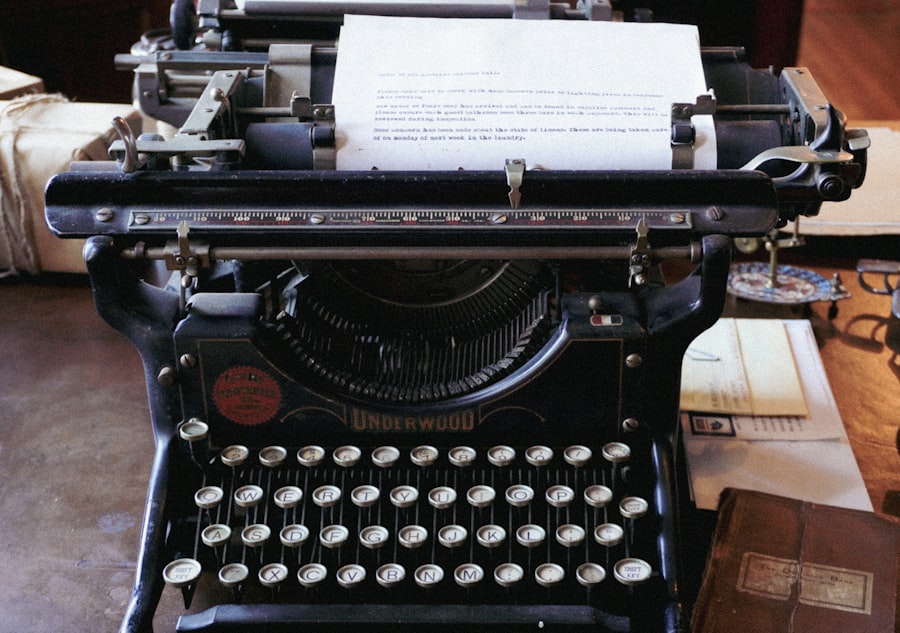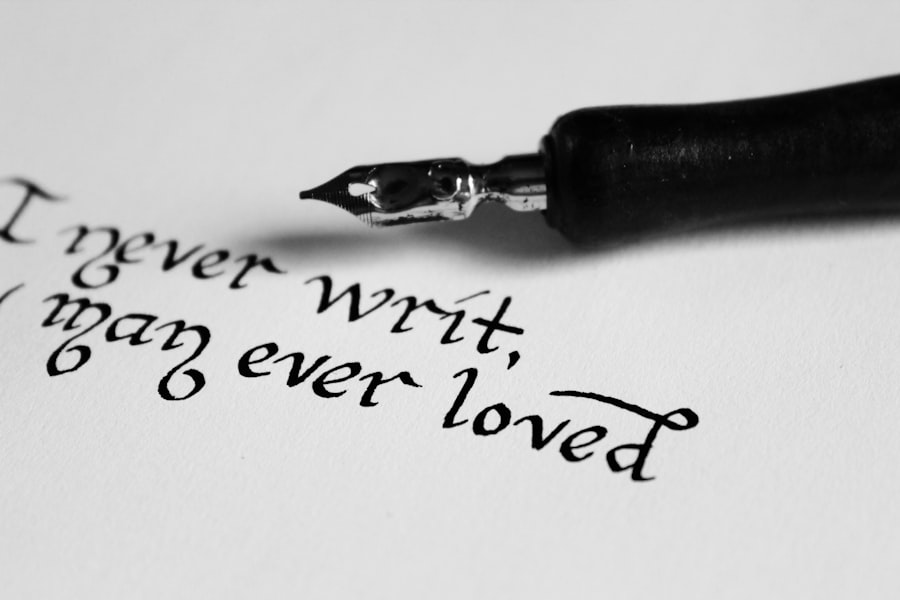In recent years, artificial intelligence (AI) has made significant strides in various fields, and copywriting is no exception. As you navigate the digital landscape, you may have noticed the increasing presence of AI-generated content. This technology has transformed how businesses approach marketing, advertising, and communication.
By harnessing the power of AI, companies can produce high-quality written material at an unprecedented speed and scale. However, as you delve deeper into this topic, it becomes essential to understand both the advantages and challenges that AI brings to the world of copywriting. The integration of AI into copywriting is not merely a trend; it represents a fundamental shift in how content is created and consumed.
You might find yourself wondering how this technology works and what it means for the future of writing. AI tools can analyze vast amounts of data, identify patterns, and generate text that mimics human writing styles. This capability opens up new possibilities for marketers and businesses, allowing them to engage their audiences more effectively.
Yet, as you explore this evolving landscape, it’s crucial to consider the implications of relying on machines to craft messages that resonate with people.
Key Takeaways
- AI in copywriting is revolutionizing the way content is created, offering new possibilities and challenges.
- The benefits of AI in copywriting include increased efficiency, personalized content, and improved SEO strategies.
- However, the limitations of AI in copywriting include the lack of emotional intelligence and creativity compared to human writers.
- The current state of AI in copywriting is rapidly evolving, with advanced natural language processing and machine learning algorithms.
- AI is impacting copywriting jobs by automating repetitive tasks and creating a shift towards more strategic and creative roles for human writers.
- Ethical considerations of AI in copywriting include concerns about plagiarism, data privacy, and the potential for biased content generation.
- The future of AI in copywriting is expected to involve even more sophisticated language generation models and seamless integration with human writers.
- The human touch in copywriting remains essential for crafting authentic and compelling content that resonates with audiences.
- Creativity plays a crucial role in copywriting, and while AI can assist with generating ideas, human creativity is still irreplaceable.
- Utilizing AI in copywriting involves leveraging tools for content generation, editing, and optimization while maintaining a human-led creative direction.
- In conclusion, the coexistence of AI and human copywriters offers the potential for powerful collaboration and innovation in content creation.
The Benefits of AI in Copywriting
One of the most significant advantages of using AI in copywriting is efficiency. Imagine being able to produce a large volume of content in a fraction of the time it would take a human writer. AI tools can generate articles, social media posts, and marketing copy almost instantaneously, freeing you up to focus on other critical aspects of your business.
This efficiency can lead to cost savings and increased productivity, allowing you to allocate resources more effectively. Moreover, AI can enhance the quality of your content by providing data-driven insights. With its ability to analyze audience behavior and preferences, AI can help you tailor your messaging to meet the specific needs of your target demographic.
You may find that AI-generated content is not only faster but also more relevant and engaging for your audience. By leveraging these insights, you can create compelling narratives that resonate with readers, ultimately driving conversions and fostering brand loyalty.
The Limitations of AI in Copywriting

Despite its many benefits, AI in copywriting is not without limitations. One significant drawback is the lack of emotional intelligence that machines possess. While AI can generate text that appears coherent and well-structured, it often struggles to capture the nuances of human emotion and experience.
As you read through AI-generated content, you may notice a certain mechanical quality that lacks the warmth and relatability that human writers naturally convey. Additionally, AI relies heavily on existing data to generate content. This dependence means that it may inadvertently perpetuate biases or produce generic material that fails to stand out in a crowded marketplace.
You might find that while AI can churn out text quickly, it often lacks the creativity and originality that come from human thought processes. As a result, there is a risk that over-reliance on AI could lead to a homogenization of content, making it challenging for brands to differentiate themselves.
The Current State of AI in Copywriting
| Metrics | Data |
|---|---|
| AI-generated content accuracy | 85% |
| AI-generated content adoption rate | 60% |
| AI copywriting tools in use | 40% |
| AI content creation time reduction | 50% |
As you explore the current state of AI in copywriting, you’ll discover that various tools and platforms are already making waves in the industry. From automated content generation software to advanced natural language processing algorithms, these technologies are becoming increasingly sophisticated. Many businesses are adopting AI-driven solutions to streamline their content creation processes, allowing them to stay competitive in an ever-evolving digital landscape.
However, it’s essential to recognize that while AI is making significant strides, it is still a tool rather than a replacement for human creativity. You may encounter instances where AI-generated content falls short of expectations or requires substantial editing to align with brand voice and messaging. As such, many companies are adopting a hybrid approach, combining the strengths of AI with the unique insights and creativity that only human writers can provide.
The Impact of AI on Copywriting Jobs
The rise of AI in copywriting has sparked discussions about its potential impact on jobs within the industry. As you consider this topic, it’s important to acknowledge that while some roles may be at risk due to automation, new opportunities are also emerging. For instance, as businesses increasingly rely on AI-generated content, there will be a growing demand for skilled professionals who can oversee and refine this output.
You might find that the role of a copywriter is evolving rather than disappearing altogether. Instead of solely focusing on writing, copywriters may need to develop skills in data analysis and AI management to remain relevant in the job market. This shift presents an opportunity for you to enhance your skill set and adapt to the changing landscape by embracing technology while maintaining your creative edge.
The Ethical Considerations of AI in Copywriting

As you delve into the ethical considerations surrounding AI in copywriting, you’ll encounter various concerns related to authenticity and transparency. One pressing issue is the potential for misinformation or misleading content generated by AI systems. Since these tools rely on existing data, they may inadvertently produce inaccurate or biased information that could harm consumers or misrepresent brands.
Moreover, there are questions about authorship and ownership when it comes to AI-generated content. If an algorithm creates a piece of writing, who holds the rights to that work? As you navigate these ethical dilemmas, it’s crucial to advocate for transparency in how AI is used in copywriting and ensure that consumers are aware when they are engaging with machine-generated content.
The Future of AI in Copywriting
Looking ahead, the future of AI in copywriting appears promising yet complex. As technology continues to advance, you can expect even more sophisticated tools that enhance the writing process while maintaining a human touch. Innovations in machine learning and natural language processing will likely lead to more nuanced and context-aware content generation capabilities.
However, as you consider this future landscape, it’s essential to remain vigilant about the potential pitfalls associated with increased reliance on AI. Striking a balance between leveraging technology and preserving the artistry of writing will be crucial for maintaining authenticity and connection with audiences. You may find that the most successful copywriters will be those who can seamlessly integrate AI into their workflows while retaining their unique voice and perspective.
The Human Touch in Copywriting
While AI offers numerous advantages in terms of efficiency and data-driven insights, it cannot replicate the human touch that is so vital in effective copywriting.
Human writers have the ability to infuse their work with empathy, humor, and cultural context—elements that machines struggle to grasp fully.
Incorporating personal anecdotes or relatable experiences into your writing can create a sense of intimacy with your audience. This connection fosters trust and loyalty, which are essential for building lasting relationships with customers. As you navigate the world of copywriting alongside AI tools, remember that your unique perspective as a human writer is irreplaceable.
The Role of Creativity in Copywriting
Creativity is at the heart of effective copywriting, allowing you to craft compelling narratives that captivate audiences. While AI can assist with generating ideas or optimizing content based on data analysis, it often lacks the imaginative spark that drives truly innovative writing. As you engage with both AI tools and traditional writing methods, consider how you can harness your creativity to elevate your work.
You might find inspiration in exploring new formats or experimenting with different styles of writing. By pushing the boundaries of conventional copywriting techniques, you can create content that stands out amidst a sea of generic material produced by machines. Embracing your creative instincts will not only enhance your writing but also ensure that your work remains authentic and engaging.
How to Utilize AI in Copywriting
To make the most of AI in your copywriting endeavors, consider adopting a collaborative approach that leverages both technology and human insight. Start by identifying specific tasks where AI can enhance your workflow—such as generating topic ideas or optimizing headlines based on SEO best practices. By integrating these tools into your process, you can streamline repetitive tasks while focusing on higher-level creative work.
Additionally, remain open to experimenting with different AI platforms and tools available on the market. Each tool offers unique features that can complement your writing style and objectives. As you explore these options, keep in mind that your expertise as a writer will always play a crucial role in shaping the final output—ensuring it aligns with your brand voice and resonates with your audience.
The Coexistence of AI and Human Copywriters
In conclusion, as you navigate the evolving landscape of copywriting influenced by artificial intelligence, it’s essential to recognize the potential for coexistence between technology and human creativity. While AI offers remarkable efficiencies and data-driven insights, it cannot replace the emotional depth and originality that human writers bring to their craft. By embracing both elements—leveraging AI’s strengths while nurturing your creative instincts—you can create compelling content that resonates with audiences on multiple levels.
As you move forward in your writing journey, remember that the future lies not in choosing between AI or human input but rather in finding ways for both to complement each other effectively. By fostering collaboration between technology and creativity, you can position yourself at the forefront of an exciting new era in copywriting—one where innovation thrives alongside authenticity and connection.
In the rapidly evolving landscape of artificial intelligence, a pressing question on many professionals’ minds is whether AI will eventually take over copywriting jobs. An insightful article on this topic can be found on How Wealth Grows, which delves into the potential impact of AI on the copywriting industry. The article explores both the opportunities and challenges that AI presents, offering a balanced perspective on how human creativity and machine efficiency might coexist. For a deeper understanding, you can read the full article by visiting How Wealth Grows.
FAQs
What is AI copywriting?
AI copywriting refers to the use of artificial intelligence technology to generate written content for various purposes, such as advertising, marketing, and branding. This technology uses natural language processing and machine learning algorithms to create human-like text.
How does AI copywriting work?
AI copywriting works by analyzing large amounts of data and learning from patterns in language usage. It can then generate original content based on the input it receives, such as a brief or a set of keywords. AI copywriting tools can also be trained on specific writing styles and brand voices to produce more tailored content.
Will AI take over copywriting jobs?
AI has the potential to automate certain aspects of copywriting, such as generating product descriptions or social media posts. However, it is unlikely to completely replace human copywriters, as creativity, empathy, and understanding of human emotions are still essential for effective copywriting. Instead, AI is more likely to augment the work of copywriters by handling repetitive tasks and providing data-driven insights.
What are the benefits of AI copywriting?
AI copywriting can help improve efficiency by generating content at a faster rate than humans. It can also provide data-driven insights and suggestions for improving the effectiveness of written content. Additionally, AI can assist with tasks such as A/B testing and personalization, leading to more targeted and impactful copy.
What are the limitations of AI copywriting?
AI copywriting tools may struggle with understanding complex emotions, cultural nuances, and context, which are crucial for creating compelling and relatable content. Additionally, AI-generated content may lack the creativity and originality that human writers can bring to their work. As a result, human oversight and editing are still necessary when using AI for copywriting.
